BEST MEAT CLEAVERS TO BUY IN 2022
- weight
- material the cleaver handle is made of
- material the blade is made of
- cleaver length
- one or multiple piece design
BEST MEAT CLEAVERS COMPARISON
| Model | Model # | Overall Rating | Weight | Review | |
|---|---|---|---|---|---|
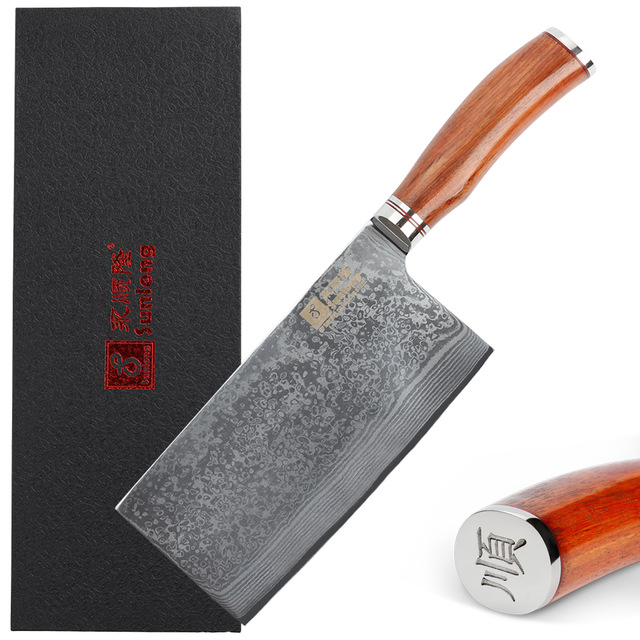 | YOUSUNLONG Damascus 7-inch Meat Cleaver | 231 g | YOUSUNLONG Review | CHECK PRICE | |
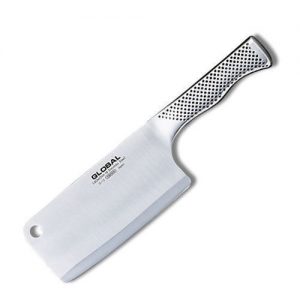 | Global G12 G-12 Japanese Meat Chopper Cleaver Knife | 998 g | Global G12 Review | CHECK PRICE | |
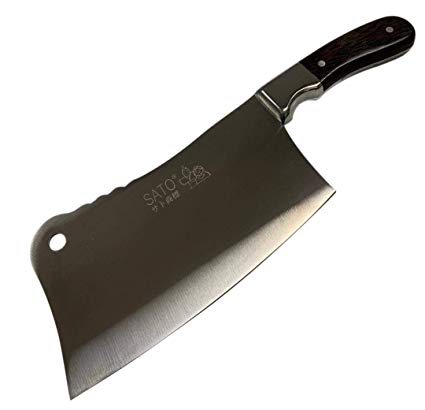 | Sato Forged Heavy-Duty Meat Cleaver | 726 g | Sato Forged Review | CHECK PRICE | |
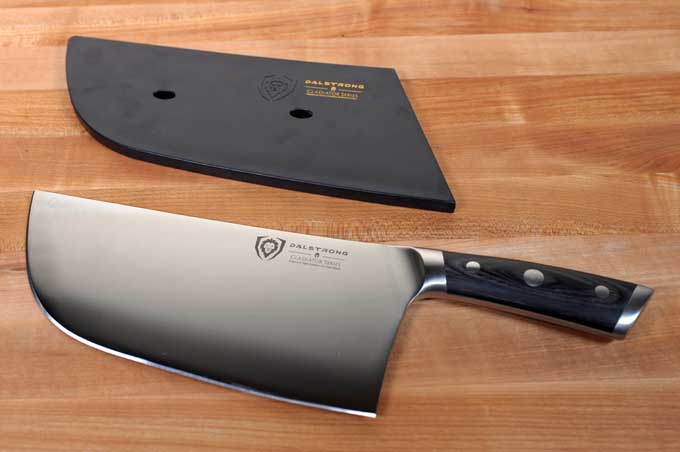 | DALSTRONG Cleaver Butcher Knife "The Ravenger" | 1.22 Kg | DALSTRONG Review | CHECK PRICE | |
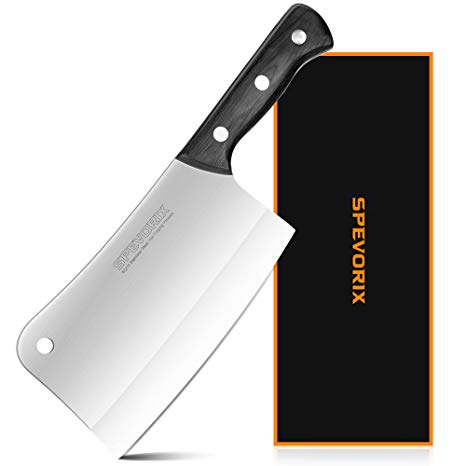 | SPEVORIX Stainless Steel Meat Cleaver | 1.2 Kg | SPEVORIX Stainless Review | CHECK PRICE | |
Matt, Owner of Bigwig Jerky Co.

OUR BEST MEAT CLEAVER REVIEWS FOR 2022
YOUSUNLONG Damascus 7-inch Meat Cleaver
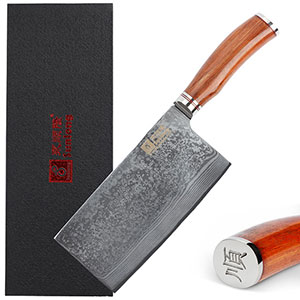
This multipurpose meat cleaver is made of Damascus steel – a well-known high-quality material. The handle is constructed from polished rosewood on the outside. Underneath the rosewood is one piece of die-casting molding.
The 7-inch blade is extremely sharp, making it a great choice for chopping meat and vegetables. Unfortunately, because it is not a very blunt edge, you should not cut through bone with this blade. It is not strong enough to cut through bone and you could end up damaging the knife.
This meat cleaver’s HRC (Hardness Rockwell C) comes in at 58-60, making it extremely hard. Thanks to the quality of the steel, this blade will last you for a very long time without having to be sharpened. The steel is VG-10 which is a special designation for a specific type of stainless steel. The G in “VG” stands for “gold standard”. This refers the measurements that this steel has met. This is a very high quality steel that is produced in Japan. VG10 is actually the most common kind of steel found in kitchen knives used by professional chefs because of its durability and corrosion resistance. VG10 knives are more expensive than lesser quality steels but the benefits you receive from it are well worth the cost.
Global G12 G-12 Japanese Meat Chopper Cleaver Knife
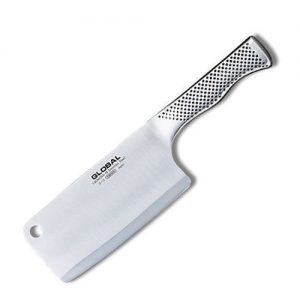
This meat cleaver is made from tempered stainless steel. Steel is often tempered in order to reduce brittleness as well as make the material more resilient. The steel must first be heated to an extremely high temperature for a few hours and then allowed to cool down to room temperature. Properly tempered steel will prove to have a good balance of toughness, hardness, and resistance to corrosion. This knife has an HRC level of 56-58, making it relatively hard.
The handle is made out of steel as well, giving it an aesthetically pleasing and seamless construction. The handle is also hollow and features dimples. These dimples give the user a stronger grip. The hollowness of the handle helps to give a feeling of lightness to the overall weight. The ergonomic shaping of the handle makes holding the meat cleaver a true pleasure.
Unfortunately, even though this blade is supposed to be extremely sharp, it actually arrives rather dull. You will most likely have to sharpen it before using. But once you get it sharpened, it should be good to go and help you cut through the toughest pieces of meat. The top corner of the cleaver also has a small hole, allowing you to hang it on a hook. This meat cleaver is on the expensive side so chefs on a budget may want to look elsewhere.
Sato Forged Heavy-Duty Meat Cleaver
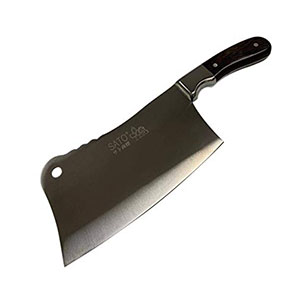
As the name implies, this Sato meat cleaver will chop through bones like its nothing. Weighing in at 1.6 lbs, it is a relatively heavy knife but that weight is what helps give you the force necessary to cut through bone. It also features a nice balance between blade and handle weight. Like the other blades, this one is made out of stainless steel. Your Sato knife shouldn’t rust or stain. The walnut wood handle has a nice grip and feels comfortable in the hand. This is truly a multipurpose knife as you can cut through carcasses, meats, poultry, fish, fruits, and vegetables.
You will have to regularly sharpen this knife in order to make sure that it maintains its good condition. Using a dull knife can be dangerous, ineffective, and even unsanitary. This blade is also wide and broad. This makes it easier to chop and scoop your food. Wide blades are also helpful at crushing garlic and other foods.
The Sato Forged Heavy-Duty Meat Cleaver Chopping Butcher Knife is useful for beginners because it is easy to use and gets consistent results. Unfortunately, for those just getting started in the world of meat cleavers, this one is rather expensive. With that said, it can be viewed as a worthwhile investment assuming the chef would get enough use out of it.
DALSTRONG Cleaver Butcher Knife The Ravenger
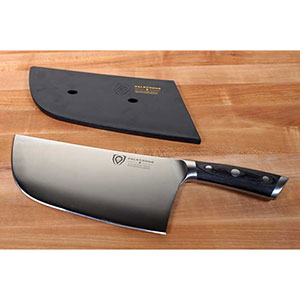
The Dalstrong Gladiator Series 9” heavy duty ‘Ravenger’ cleaver is meant for serious chopping. From pork bones to salmon heads to pounds of chicken, this cleaver can do it all. Coming in at 1.3 lbs, this is meat cleaver has an excellent weight for performing all sorts of tasks. The 8 inch, high-carbon German steel blade is incredibly sharp. This makes it versatile at not just chopping but also mincing, dicing, and slicing. Its Rockwell rating is 55, meaning that it is hard but not as hard as some of the other blades we’ve listed. They also offer a lifetime warranty and 100% satisfaction guarantee or your money back.
The handle is made from black pakkawood. It is also triple riveted and the sturdy grip feels comfortable in the hand. Compared to the other knives in Dalstrong’s Gladiator series, “The Ravenger” has an extra thick handle. This helps you get a good hold on this relatively heavy knife. The handle is also polished and laminated which helps to keep it sanitary.
These knives are hand sharpened to 14 – 16 degrees per side for superb sharpness. Unfortunately, some users have reported that the knife has arrived dull and they had to sharpen it themselves. The stainless steel end caps provide both a counter balance as well as a level of distinction to this knife.
SPEVORIX Stainless Steel Meat Cleaver
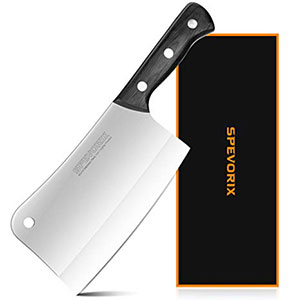
The heaviest knife on this list, the Spevorix stainless steel meat cleaver comes in weighing a little over 2.5 lbs. The 7-inch blade has a Rockwell hardness of 54, meaning that it is relatively hard. It is made of 100% stainless steel and is sharp yet durable. You can cut through pretty much anything with this knife thanks to its heavy weight. Try it on bones as well as hard fruits like coconuts shells and pineapples. The hole in the top corner of the blade allows you to hang the knife on a rack for easy storage as well as kitchen aesthetics.
The handle is five inches long and is constructed of non-welding black Pakka wood. This makes it comfortable in your hands. The benefits of using a wooden handle as opposed to a stainless steel one is that the handle will not become affected by temperatures that might affect the blade. So if the blade is very cold or hot, your hand won’t feel it when wrapped around the handle.
This knife is also intended for both right as well as left handed people. Even better, this is an extremely affordable meat cleaver. Anyone who is interested in purchasing a heavy duty knife but is worried about overspending should check out this Spevorix knife.
CHOOSING THE BEST MEAT CLEAVER: BUYERS GUIDE
THINGS TO KNOW
BLADE LENGTH
BLADE HEIGHT
BALANCE
BLADE THICKNESS
WEIGHT
COMMON TYPES OF STEEL
BLADE EDGE
HANDLE
SUMMARY

OUR #1 MEAT CLEAVERS
YOUSUNLONG Damascus 7-inch Meat Cleaver

